 |
|
|
plants text index | photo
index
|
| mangroves |
| Tui or Mangrove trumpet tree Dolichandrone spathacea Family Bignoniaceae updated Jan 2013 Where seen? Several of these beautiful trees have been replanted at Sungei Buloh Wetland Reserve, Pulau Ubin and our coastal parks. According to Ng, it is confined to the back-mangrove zone and banks of tidal rivers and estuaries. The trees at Changi Point, Pulau Sakeng and sluice gates of Sungei Jurong were destroyed with recent development. According to Hsuan Keng, it was formerly common along our tidal rivers including Punggol, Bajau, Pulau Ubin, Pulau Tekong and Tanjung Gul. According to Corners, it is considered common in Malaya. According to Tomlinson, it has the widest range of the Dolichandrone and frequently found in the back mangroves which are flooded at the highest tides. Typically, it grows in swampy or beach communities such as dunes or on river banks. Features: A shrub or tree that grows to 5-20m tall. Old trees have massive trunks that are fluted at the base. Trunk cylindrical, short and often crooked. Bark grey to dark brown, shallowly ridged and fissured, slightly scaly. Compound leaves made up of 2-4 pairs of leaflets eye-shaped (6-20cm long) thin arranged opposite one another. Generally 3 pairs of leaflets with a leaflet at the tip. Young leaves are slightly pinkish and somewhat sticky. At times the tree may be nearly leafless. Flowers trumpet-shaped large (15-20cm long) white delicate with ruffled edges, in clusters of 2-10 flowers. The flowers in the cluster bloom one at a time and according to Corners "very fragrant" while Tomlinson describes it as "a pervasive scent". According to Hsuan Keng, the flower opens in the early morning and closes at noon, but according to Corners, it blooms at dusk and the flower drops off at sunrise or earlier, while Tomlinson says they bloom in the early evening and the flower usually lasts for only one day. According to Tomlinson, nectar accumulates copiously at the base of the trumpet tube. Suggestions for pollinators include very long-tongued moths (Corners), long-tongued 'nocturnal animals' probably hawk moths (Tomlinson). Apparently, no pollinators have been observed so far. Self pollination also occurs. Pods long curling bean-like (25-60cm long) and contain many seeds. The pods are green at first, turning brown. The seeds resemble small rectangular wheat biscuits; they are pale white to beige, small (about 1.5cm) flat, rectangular to square, with a corky wing. They float readily and are probably dispersed by water and not wind. Human uses: According to Burkill, the wood is light and thus was prefered by the Javanese for making saddles. It is also used in floats for fishing nets and for wooden shoes in the Philippines. According to Giersen, it is used as firewood, and also for making traditional 'wayang kulit' (shadow puppet) masks in Indonesia. Tea brewed from the leaves are used to treat mouth infections. Status and threats: It is listed as 'Critically Endangered' on the Red List of threatened plants of SIngapore. |
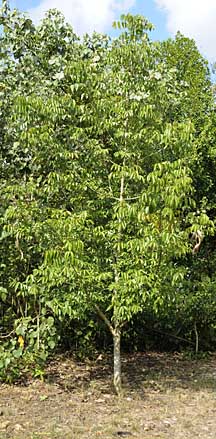 Planted tree near natural mangroves. Pulau Ubin, Jul 09 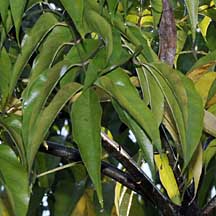 Sungei Buloh Wetland Reserve, Mar 09 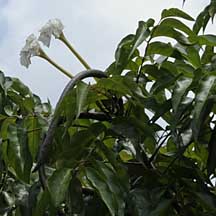 Sungei Buloh Wetland Reserve, Feb 10 |
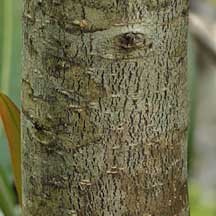 Sungei Buloh Wetland Reserve, Feb 09 |
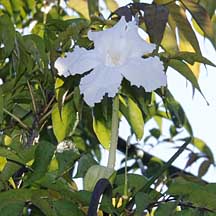 Sungei Buloh Wetland Reserve, Mar 09 |
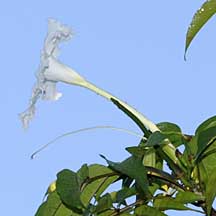 Trumpet shaped flower. Sungei Buloh Wetland Reserve, Mar 09 |
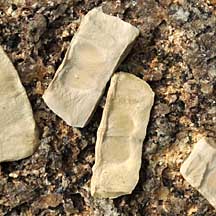 Seeds look like wheat biscuits. Sungei Buloh Wetland Reserve, Feb 09 |
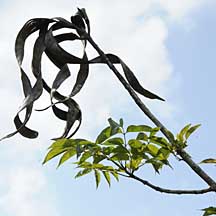 Opened pods. Pulau Ubin, Jul 09 |
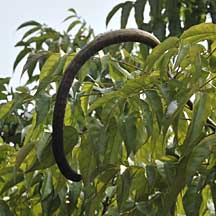 Unopened pod. Sungei Buloh Wetland Reserve, Feb 09 |
| Mangrove trumpet trees on Singapore shores |
| Photos of Mangrove trumpet trees for free download from wildsingapore flickr |
| Distribution in Singapore on this wildsingapore flickr map |
|
Links
References
|
|
|